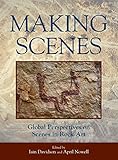Making Scenes : Global Perspectives on Scenes in Rock Art / ed. by April Nowell, Iain Davidson.
Material type: TextPublisher: New York ; Oxford : Berghahn Books, [2021]Copyright date: ©2021Description: 1 online resource (352 p.)Content type:
TextPublisher: New York ; Oxford : Berghahn Books, [2021]Copyright date: ©2021Description: 1 online resource (352 p.)Content type: - 9781789209204
- 9781789209211
- Composition (Art)
- Petroglyphs
- Rock paintings -- Themes, motives
- SOCIAL SCIENCE / Archaeology
- ancient cultures
- ancient man
- anthropology
- anthropomorphs
- archaeological
- archaeology
- art history
- art
- artists
- australia
- chauvet cave
- cognitive evolution
- creatures
- cultural
- elements of a scene
- engaging
- evolutionary history
- geography
- history
- human evolution
- lively
- living cultures
- nature
- page turner
- paintings
- phenomenon
- rock art
- scenes
- scientists
- sequential memory
- social science
- social
- symbolic expression
- western scenic art
- 759.01/13 23
- online - DeGruyter
| Item type | Current library | Call number | URL | Status | Notes | Barcode | |
|---|---|---|---|---|---|---|---|
 eBook
eBook
|
Biblioteca "Angelicum" Pont. Univ. S.Tommaso d'Aquino Nuvola online | online - DeGruyter (Browse shelf(Opens below)) | Online access | Not for loan (Accesso limitato) | Accesso per gli utenti autorizzati / Access for authorized users | (dgr)9781789209211 |
Frontmatter -- CONTENTS -- List of Illustrations -- Preface -- Introduction. Behind the Scenes: Did Scenes in Rock Art Create New Ways of Seeing the World? -- Chapter 1. Scenes and Non-Scenes in Rock Art -- Chapter 2. The Possible Signifi cance of Depicted Scenes for Cognitive Development -- Chapter 3. Event Depiction in Rock Art: Landscape-Embedded Plan-View Narratives, Decontextualized Profile “Scenes,” and Their Hybrid Instances -- Chapter 4. Defining “Scenes” in Rock Art Research: Visual Conventions and Beyond -- Chapter 5. Putting Southern African Rock Paintings in Context: The View from the Mirabib Rock Shelter, Western Namibia -- Chapter 6. Scenic Narratives of Humans and Animals in Namibian Rock Art: A Methodological Restart with Data Mining -- Chapter 7. Between Scene and Association: Toward a Better Understanding of Scenes in the Rock Art of Iran -- Chapter 8. Music and Dancing Scenes in the Rock Art of Central India -- Chapter 9. Hunting and Havoc: Narrative Scenes in the Black Desert Rock Art of Jebel Qurma, Jordan -- Chapter 10. Making a Scene: An Analysis of Rock Art Panels from the Northwest Kimberley and Central Desert, Australia -- Chapter 11. Scene but Not Heard: Seeing Scenes in a Northern Australian Aboriginal Site -- Chapter 12. A Comparison of “Scenes” in Parietal and Non-Parietal Upper Paleolithic Imagery: Formal Differences and Ontological Implications -- Chapter 13. Scene Makers: Finger Fluters in Rouffignac Cave, France -- Chapter 14. Maps in Prehistoric Art -- Chapter 15. Scenes in the Paleolithic and Levantine Art of Eastern Spain -- Chapter 16. New Insights into the Analysis of Levantine Rock Art Scenes Informed by Observations on Western Arnhem Land Rock Art -- Chapter 17. Rules of Ordering and Grouping in the Pitoti, the Later Prehistoric Rock Engravings of Valcamonica (BS), Italy: from Solitary Figures through Clusters, Graphic Groups, and Scenes to Narrative -- Chapter 18. Finding Order out of Chaos: A Statistical Analysis of Nine Mile Canyon Rock Art -- Chapter 19. Interpreting Scenes in the Rock Art of the Canadian Maritimes -- Chapter 20. The “Black Series” in the Hunting Scenes of Cueva de las Manos, Río Pinturas, Patagonia, Argentina -- Epilogue. Is There More to Scenes than Meets the Eye? -- INDEX
restricted access online access with authorization star
http://purl.org/coar/access_right/c_16ec
Dating back to at least 50,000 years ago, rock art is one of the oldest forms of human symbolic expression. Geographically, it spans all the continents on Earth. Scenes are common in some rock art, and recent work suggests that there are some hints of expression that looks like some of the conventions of western scenic art. In this unique volume examining the nature of scenes in rock art, researchers examine what defines a scene, what are the necessary elements of a scene, and what can the evolutionary history tell us about storytelling, sequential memory, and cognitive evolution among ancient and living cultures?
Mode of access: Internet via World Wide Web.
In English.
Description based on online resource; title from PDF title page (publisher's Web site, viewed 25. Jun 2024)


